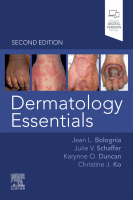Physical Address
304 North Cardinal St.
Dorchester Center, MA 02124

This group of disorders, in an untreated state, is characterized by infiltrates of neutrophils within the skin. In addition, these dermatoses lack an identifiable infectious etiology, despite the presence of neutrophils ( Fig. 21.1 ). There can be significant overlap…

As with the group of disorders known as neutrophilic dermatoses, there is significant overlap in the cutaneous findings of entities where eosinophils play a role – from papular urticaria triggered by arthropod bites to Wells syndrome and hypereosinophilic syndrome (…

Vasculitis is characterized by an inflammatory infiltrate that targets blood vessels and leads to destruction of their walls. Cutaneous vasculitis can occur in isolation or together with involvement of other organs; in the latter scenario, skin findings may represent important…

Purpura represents visible hemorrhage into the skin or mucous membranes; in contrast to erythema due to vasodilation, it is nonblanching upon application of external pressure. Purpura can be primary , where hemorrhage is an integral part of lesion formation, or…

You’re Reading a Preview Become a Clinical Tree membership for Full access and enjoy Unlimited articles Become membership If you are a member. Log in here

You’re Reading a Preview Become a Clinical Tree membership for Full access and enjoy Unlimited articles Become membership If you are a member. Log in here

A number of cutaneous diseases can have an annular, arciform, or polycyclic configuration, from urticaria to granuloma annulare and tinea corporis ( Table 15.1 ). Sites of involvement, rate of expansion, and characteristics of the border assist in narrowing the…

Urticaria and angioedema can occur at any age and are estimated to have an overall lifetime prevalence of 10–25%. Urticaria (hives) is characterized by wheals : evanescent, pale to pink-red, edematous papules or plaques ( Fig. 14.1 ); lesions often…

Some inflammatory, infectious, metabolic, neoplastic, and genetic skin conditions have a predilection for particular areas of the body. This chapter addresses the diagnosis and treatment of regional dermatoses affecting the hands, feet, intertriginous regions, diaper area, lips, and eyelids. Dermatitis…

Key Points Irritant contact dermatitis (ICD) – Accounts for 80% of all causes of contact dermatitis – Secondary to a local toxic effect caused by a topical substance or physical insult Allergic contact dermatitis (ACD) – Accounts for 20% of…